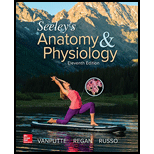
Seeley's Anatomy & Physiology
11th Edition
ISBN: 9780077736224
Author: Cinnamon VanPutte, Jennifer Regan, Andrew F. Russo Dr., Rod R. Seeley Dr.
Publisher: McGraw-Hill Education
expand_more
expand_more
format_list_bulleted
Concept explainers
Question
Chapter 3.4, Problem 10AYP
Summary Introduction
To determine:
The function of cholesterol in plasma membranes.
Introduction:
The cell membrane is formed from two types of molecules. These are phospholipids and proteins. The phospholipids are a type of lipid molecules that form a bilayer structure. This layer protects the cell from the external environment. All cell membrane contains lipids.
Expert Solution & Answer
Want to see the full answer?
Check out a sample textbook solution
Students have asked these similar questions
Despite two individuals having high BMI with similar values, one person is more susceptible to cardiovascular disease than the other. This persons's obesity is known as
Group of answer choices
genetic obesity
dietary obesity
android obesity
gynoid obesity
It is generally believed that earlier adaptation to cold would affect survival in hypoxia. This effect is known as-
Group of answer choices
habituation
negative acclimatization
positive acclimation
accommodation
How is convection altered in a hot sauna room? What would be the net heat exchange? Use appropriate formula to explain.
Chapter 3 Solutions
Seeley's Anatomy & Physiology
Ch. 3.1 - What parts are common to most cells?Ch. 3.1 - Explain the four characteristic functions of the...Ch. 3.2 - Which cell features can be seen with a light...Ch. 3.3 - Explain five functions of the plasma membrane.Ch. 3.3 - Prob. 5AYPCh. 3.3 - Prob. 6AYPCh. 3.3 - What are the main chemical components of the...Ch. 3.4 - Prob. 8AYPCh. 3.4 - Summarize the characteristics of the fluid-mosaic...Ch. 3.4 - Prob. 10AYP
Ch. 3.5 - Prob. 11AYPCh. 3.5 - Prob. 12AYPCh. 3.5 - What are the three classes of transport proteins?Ch. 3.5 - Describe specificity, competition, and saturation...Ch. 3.5 - Prob. 15AYPCh. 3.5 - Prob. 16AYPCh. 3.5 - Prob. 17AYPCh. 3.5 - Prob. 18AYPCh. 3.5 - Prob. 19AYPCh. 3.5 - Prob. 20AYPCh. 3.6 - Explain why the plasma membrane is selectively...Ch. 3.6 - Prob. 22AYPCh. 3.6 - Describe how the amount of solute in a solvent...Ch. 3.6 - How is the rate of diffusion affected by an...Ch. 3.6 - Prob. 25AYPCh. 3.6 - Compare isosmotic, hyperosmotic, and hyposmotic...Ch. 3.6 - Prob. 27AYPCh. 3.6 - Prob. 28AYPCh. 3.6 - What is secondary active transport? Describe how...Ch. 3.6 - Prob. 30AYPCh. 3.6 - Prob. 31AYPCh. 3.6 - Prob. 32AYPCh. 3.6 - Describe and give examples of exocytosis.Ch. 3.7 - Prob. 34AYPCh. 3.7 - Prob. 35AYPCh. 3.7 - List and describe the functions of microtubules,...Ch. 3.7 - What are cytoplasmic inclusions? Give several...Ch. 3.8 - Define organelles. Are oil orgonelles found in oil...Ch. 3.8 - Describe the structure of the nucleus and the...Ch. 3.8 - Prob. 40AYPCh. 3.8 - Prob. 41AYPCh. 3.8 - Prob. 42AYPCh. 3.8 - What molecules combine to form ribosomes? Where...Ch. 3.8 - Prob. 44AYPCh. 3.8 - Prob. 45AYPCh. 3.8 - What are the functions of the rough endoplasmic...Ch. 3.8 - Prob. 47AYPCh. 3.8 - Relate the structure and function of the Golgi...Ch. 3.8 - Prob. 49AYPCh. 3.8 - Prob. 50AYPCh. 3.8 - Prob. 51AYPCh. 3.8 - Prob. 52AYPCh. 3.8 - What are the structure and function of...Ch. 3.8 - Describe the structure of a mitochondrion. How...Ch. 3.8 - What enzymes are found on the cristae? In the...Ch. 3.8 - What is the centrosome? Relate the structure of...Ch. 3.8 - What are spindle fibers? Explain the relationship...Ch. 3.8 - Prob. 58AYPCh. 3.8 - Prob. 59AYPCh. 3.9 - Prob. 60AYPCh. 3.9 - Prob. 61AYPCh. 3.9 - Prob. 62AYPCh. 3.9 - Prob. 63AYPCh. 3.9 - Prob. 64AYPCh. 3.9 - Prob. 65AYPCh. 3.9 - Prob. 66AYPCh. 3.9 - Place the steps of translation in sequence. In...Ch. 3.9 - Prob. 68AYPCh. 3.9 - State two ways the cell controls what part of DNA...Ch. 3.10 - Describe the cell’s activities during the G1, S....Ch. 3.10 - Prob. 71AYPCh. 3.10 - Prob. 72AYPCh. 3.10 - Prob. 73AYPCh. 3.10 - Differentiate among chromot in, chromcitids, and...Ch. 3.10 - Prob. 75AYPCh. 3.10 - Prob. 76AYPCh. 3.10 - Prob. 77AYPCh. 3.11 - Prob. 78AYPCh. 3 - In the plasma membrane, _____ form(s) the lipid...Ch. 3 - Which of the following functioning proteins are...Ch. 3 - In general, lipid-soluble molecules diffuse...Ch. 3 - Small pieces of matter, and even whole cells, can...Ch. 3 - The rate of diffusion increases if the a....Ch. 3 - Concerning the process of diffusion, at...Ch. 3 - Prob. 7RACCh. 3 - Prob. 8RACCh. 3 - Which of these statements about facilitated...Ch. 3 - Which of these statements concerning the symport...Ch. 3 - A white blood cell ingests solid particles by...Ch. 3 - Given these characteristics: (1) requires energy...Ch. 3 - Cytoplasm is found a. in the nucleus. b. outside...Ch. 3 - Which of these elements of the cytoskeleton is...Ch. 3 - A large structure, normally visible in the nucleus...Ch. 3 - A cell that synthesizes large amounts of protein...Ch. 3 - Which of thes organelles produces large amounts of...Ch. 3 - Prob. 18RACCh. 3 - A portion of an mRNA molecule that determines one...Ch. 3 - In which of these organelles is m RNA synthesized?...Ch. 3 - During the cell cycle, DNA replication occurs...Ch. 3 - Given the following activities: Repair Growht...Ch. 3 - Apoptosis Is a programmed cell death. Removes...Ch. 3 - Prob. 1CTCh. 3 - Prob. 2CTCh. 3 - Prob. 3CTCh. 3 - Prob. 4CTCh. 3 - Luke started a training program at the beginning...Ch. 3 - Prob. 6CT
Knowledge Booster
Learn more about
Need a deep-dive on the concept behind this application? Look no further. Learn more about this topic, biology and related others by exploring similar questions and additional content below.Similar questions
- How have the Arctic Inuits (people living in the Arctic) been able to stay in such cold conditions for so long? List and explain your reasons.arrow_forwardRecently I saw an action movie where the kidnappers accidentally killed the business tycoon by immersing his face in ice water. What could be the cause of death in this case? Group of answer choices vasodilation of peripheral vessels restriction of limb movement cardiac arrhythmia inability to open the eyesarrow_forwardBesides lack of food, what are the other physiological conditions that exacerbate the effects of starvation in developing countries?arrow_forward
- 1. A few years back, the faculty in Biology department faced complete loss of their research labs and office space due to unexpected flooding. This was early in the morning when students had come on-campus for their classes and faculty were ready to start teaching. a. Briefly explain the pathway that would have been activated in this acute stress. b. Also, considering that it was a while before things resumed to normal, explain what the effects of chronic stress under such conditions were.arrow_forwardwhich produces such as Cellular Respiration begins with NAD+ which is broken down during, to make which produces which occurs in the in the presence of anaerobic respiration that is used in pyruvate that is used in aerobic respiration alcohol such as which produces which is used in the to make 32 ATP -which produces which occurs in the starting with which occurs in thearrow_forwardDay 3-A: Venn Diagram Directions: Using the Venn diagram, describe a pure substance using the properties of elements and compounds. Write only the letters corresponding to your responses. PURE SUBSTANCE ELEMENTS COMPOUNDS A. It is the simplest form of matter.. B. It cannot be separated into simpler components by chemical means. C. It is made by two or more elements combined. D. It serves as the building block of other substances. E. Examples are oxygen, hydrogen, carbon, and gold. F. It can be separated into simpler substances by chemical means. G. It is represented by a chemical formula. H. Examples are water, sugar, salt, and baking soda. 3arrow_forward
- Describe in details the two molecular processes in steroid and peptide actionarrow_forwardCan you choose one topic of interest associated with microbiology, human diseases and / or human health.arrow_forwardPatients identified as at risk for falling are the most likely to suffer an Unanticipated Physiological fallarrow_forward
arrow_back_ios
SEE MORE QUESTIONS
arrow_forward_ios
Recommended textbooks for you
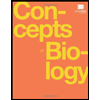 Concepts of BiologyBiologyISBN:9781938168116Author:Samantha Fowler, Rebecca Roush, James WisePublisher:OpenStax College
Concepts of BiologyBiologyISBN:9781938168116Author:Samantha Fowler, Rebecca Roush, James WisePublisher:OpenStax College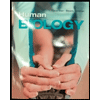 Human Biology (MindTap Course List)BiologyISBN:9781305112100Author:Cecie Starr, Beverly McMillanPublisher:Cengage Learning
Human Biology (MindTap Course List)BiologyISBN:9781305112100Author:Cecie Starr, Beverly McMillanPublisher:Cengage Learning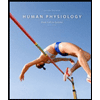 Human Physiology: From Cells to Systems (MindTap ...BiologyISBN:9781285866932Author:Lauralee SherwoodPublisher:Cengage Learning
Human Physiology: From Cells to Systems (MindTap ...BiologyISBN:9781285866932Author:Lauralee SherwoodPublisher:Cengage Learning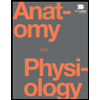 Anatomy & PhysiologyBiologyISBN:9781938168130Author:Kelly A. Young, James A. Wise, Peter DeSaix, Dean H. Kruse, Brandon Poe, Eddie Johnson, Jody E. Johnson, Oksana Korol, J. Gordon Betts, Mark WomblePublisher:OpenStax College
Anatomy & PhysiologyBiologyISBN:9781938168130Author:Kelly A. Young, James A. Wise, Peter DeSaix, Dean H. Kruse, Brandon Poe, Eddie Johnson, Jody E. Johnson, Oksana Korol, J. Gordon Betts, Mark WomblePublisher:OpenStax College

Concepts of Biology
Biology
ISBN:9781938168116
Author:Samantha Fowler, Rebecca Roush, James Wise
Publisher:OpenStax College

Human Biology (MindTap Course List)
Biology
ISBN:9781305112100
Author:Cecie Starr, Beverly McMillan
Publisher:Cengage Learning

Human Physiology: From Cells to Systems (MindTap ...
Biology
ISBN:9781285866932
Author:Lauralee Sherwood
Publisher:Cengage Learning

Anatomy & Physiology
Biology
ISBN:9781938168130
Author:Kelly A. Young, James A. Wise, Peter DeSaix, Dean H. Kruse, Brandon Poe, Eddie Johnson, Jody E. Johnson, Oksana Korol, J. Gordon Betts, Mark Womble
Publisher:OpenStax College

